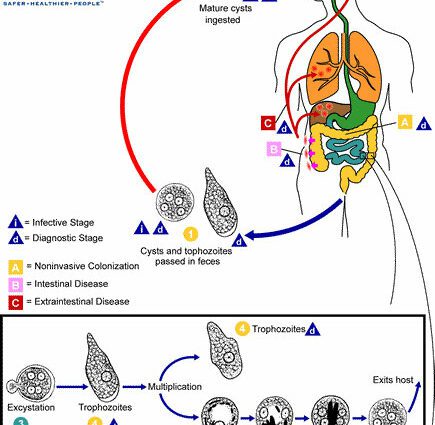Contents
Amebiasis: definition, symptoms and treatments
Amebiasis is the third deadliest parasitic disease in the world. About 10% of the world’s population is believed to be infected with parasitic amoebae. Often asymptomatic, however, the infection can lead to many complications. How to detect and treat it?
What is an amoebiasis?
Amebiasis is a condition related to an infection caused by a microscopic parasite that settles in the intestine. This disease remains a global public health problem, because it affects more than 50 million patients worldwide, due to a lack of sanitary and water hygiene.
Amoebae are found all over the world, but are more prevalent in tropical countries as well as in hot and humid regions with poor hygiene standards.
The infection is usually asymptomatic and clinical signs range from mild diarrhea to hospitalization.
Diagnosis is based on identification of E. histolytica in the stool and by serological testing.
What are the causes of amebiasis?
Amebiasis is caused by the amoeba “Entamoeba histolytica”, a parasite characteristic of humans. This parasitosis rages throughout the year but lives only in water or in the presence of high humidity. In other areas, it may appear as small epidemics or isolated cases.
Amoeba belongs to the family of protozoa. Entemoeba histolytica is the only amoeba capable of penetrating the lining of the intestine and its wall. This parasite can take two forms, an active form (trophozoite) and a dormant form (cyst).
The infection begins when the cysts have been absorbed. Indeed, when they are born, they deliver trophozoites which multiply and cause signs of inflammation, the consequences of which are an intestinal infection.
Sometimes they spread to the liver or other parts of the body.
Contamination methods are carried out directly (from man to man) or indirectly (through food and water). In areas where hygiene is poor, amebiasis is spread through the consumption of food or water contaminated with feces.
What are the symptoms of amebiasis?
Most people with amoebiasis are asymptomatic, but symptoms may appear a few days or weeks after infection.
The primary amoebic invasion corresponds to the initial infection of the intestine by the amoeba, while the late amebiasis occurs when the primary amoebic invasion has not been treated and generally affects the liver.
Intestinal amebiasis or colic
- Early mild diarrhea without fever;
- Abdominal pain, cramps;
- Diarrhea which is prolonged and becomes stronger diarrhea: Dysentery, with blood and mucus in the mucous stools, (amoebic dysentery);
- Fatigue, weight loss and sometimes fever.
Hepatic amoebiasis
- Pain in the area where the liver is located;
- Fever ;
- Increased liver volume.
How to treat amebiasis?
When the person has symptoms, treatment is based on two drugs: one that removes the amoeba, and then another drug that kills the cysts in the large intestine.
- For mild forms of intestinal amoebiasis: taking broad-spectrum antiparasitics and contact amoebicides (metronidazole or tinidazole followed by paromomycin or another active drug to eradicate the cyst accompanied by lifestyle and dietary measures) ;
- For severe intestinal and hepatic forms, they require hospitalization and urgent treatment.
It is important to treat intestinal amebiasis well in order to avoid the appearance of extradigestive forms. Not to mention, people who have no symptoms (asymptomatic) who also need to be treated to fight against the transmission of the disease.
Prevention
To overcome the risk of catching amoebae, it is first necessary to destroy the faecal contamination of water, food and hands and implement diagnostic methods that can show the presence of cysts, including in carriers who do not ‘have no symptoms.
Waiting for :
- Avoid putting your hands to your mouth after a handshake;
- Do not use dirty cloths to dry your hands in the toilet;
- Consume encapsulated bottled mineral water;
- Eat fruits and vegetables cleaned with boiled water or after switching to chlorine;
- Monitor swimming pools by eliminating organic matter;
- Renew the water in the swimming pools.










